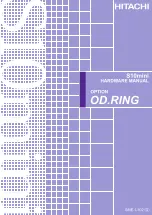
4.3.1.6
Queue Priority Register (QUEPRI)
4.3.2 Error Registers
4.3.2.1
Event Missed Registers (EMR/EMRH)
EDMA3 Channel Controller Control Registers
www.ti.com
The queue priority register (QUEPRI) allows you to change the priority of the individual queues and the
priority of the transfer request (TR) associated with the events queued in the queue. Since the queue to
EDMA3TC mapping is fixed, programming QUEPRI essentially governs the priority of the associated
transfer controller(s) read/write commands with respect to the other bus masters in the device. You can
modify the EDMA3TC priority to obtain the desired system performance. The QUEPRI is shown in
and described in
Figure 4-14. Queue Priority Register (QUEPRI)
31
16
Reserved
R-0
15
7
6
4
3
2
0
Reserved
PRIQ1
Rsvd
PRIQ0
R-0
R/W-0
R-0
R/W-0
LEGEND: R/W = Read/Write; R = Read only; -
n
= value after reset
Table 4-17. Queue Priority Register (QUEPRI) Field Descriptions
Bit
Field
Value
Description
31-7
Reserved
0
Reserved
6-4
PRIQ1
0-7h
Priority level for queue 1. Dictates the priority level used by TC1 relative to other masters in the device.
A value of 0 means highest priority and a value of 7 means lowest priority.
3
Reserved
0
Reserved
2-0
PRIQ0
0-7h
Priority level for queue 0. Dictates the priority level used by TC0 relative to other masters in the device.
A value of 0 means highest priority and a value of 7 means lowest priority.
The EDMA3CC contains a set of registers that provide information on missed DMA and/or QDMA events,
and instances when event queue thresholds are exceeded. If any of the bits in these registers is set, it
results in the EDMA3CC generating an error interrupt.
For a particular DMA channel, if a second event is received prior to the first event getting cleared/serviced,
the bit corresponding to that channel is set/asserted in the event missed registers (EMR/EMRH). All
trigger types are treated individually, that is, manual triggered (ESR/ESRH), chain triggered (CER/CERH),
and event triggered (ER/ERH) are all treated separately. The EMR/EMRH bits for a channel are also set if
an event on that channel encounters a NULL entry (or a NULL TR is serviced). If any EMR/EMRH bit is
set (and all errors, including bits in other error registers (QEMR, CCERR) were previously cleared), the
EDMA3CC generates an error interrupt. Refer to
for details on EDMA3CC error interrupt
generation.
The EMR is shown in
and described in
. The EMRH is shown in
and
described in
Registers
102
SPRUG34 – November 2008
Summary of Contents for TMS320DM357
Page 2: ...2 SPRUG34 November 2008 Submit Documentation Feedback ...
Page 12: ...List of Tables 12 SPRUG34 November 2008 Submit Documentation Feedback ...
Page 16: ...Read This First 16 SPRUG34 November 2008 Submit Documentation Feedback ...
Page 64: ...EDMA3 Architecture 64 SPRUG34 November 2008 Submit Documentation Feedback ...
















































